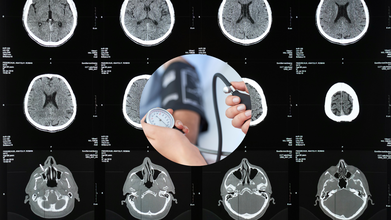- Health Conditions A-Z
- Health & Wellness
- Nutrition
- Fitness
- Health News
- Ayurveda
- Videos
- Medicine A-Z
- Parenting
Duchenne Gene Therapy: Why The FDA Has Tightened Rules Following Two Teen Deaths

Credits: Canva
The FDA on Friday revised the safety information for Sarepta Therapeutics’ Duchenne muscular dystrophy gene therapy, Elevidys, adding a boxed warning to alert patients and doctors about the risk of severe liver damage and possible death. This highest-level warning outlines the chance of serious liver injury and acute liver failure in people who receive Elevidys, with both complications carrying the possibility of being fatal.
The agency has also limited the therapy’s use to ambulatory Duchenne patients who are at least 4 years old and have a confirmed mutation in the DMD gene. With these changes, Elevidys is no longer permitted for patients who cannot walk.
What Is Duchenne Muscular Dystrophy?
Duchenne muscular dystrophy (DMD) is a serious inherited condition that leads to steady muscle weakening and loss, affecting boys far more often. It stems from a defect in the dystrophin gene, which prevents the body from making a key protein that protects muscle fibers.
Signs usually show up in early childhood and include trouble walking or climbing, frequent falls and a noticeable waddling walk, according to the Cleveland Clinic.
What Is The Duchenne Gene Therapy?
Gene therapy for Duchenne muscular dystrophy delivers a corrected or shortened form of the dystrophin gene into muscle cells using a modified virus. This allows the cells to produce a working version of the protein. The single intravenous infusion is designed to slow the disease by restoring some dystrophin, with the aim of improving movement and daily functioning. While the FDA has cleared a therapy that creates a reduced “micro-dystrophin,” researchers are still working on ways to provide the full-length gene for potentially stronger results, as noted by the Food and Drug Administration.
What Is Elevidys?
Elevidys is a gene-based treatment designed for Duchenne muscular dystrophy. It is given only once and relies on an adeno-associated virus to carry a modified form of the dystrophin gene into the body. This shorter micro-dystrophin version is meant to take the place of the faulty or absent dystrophin that leads to the condition.
FDA Tightens Duchenne Gene Therapy After Deaths Of Two Teens
The U.S. Food and Drug Administration is tightening control over a Duchenne muscular dystrophy gene therapy after two teenagers died from liver failure linked to the treatment. The agency has restricted Elevidys, made by Sarepta Therapeutics, to boys aged 4 and older who are still able to walk.
It can no longer be given to boys who have already lost the ability to move independently, something that usually occurs around age 12 in Duchenne. A safety review confirmed that both teenagers developed severe liver damage after receiving the infusion and later died.
The FDA is also adding its strongest boxed warning to call attention to the risks of serious liver injury, acute liver failure and death. Sarepta, based in Cambridge, Massachusetts, with offices in several countries, told regulators earlier this year that it had already stopped supplying the therapy to non-ambulatory patients. The company stated that Elevidys has been used in 1,100 patients worldwide.
These updates “will ensure that families and health-care professionals have clear information” to support treatment choices, Louise Rodino-Klapac, Sarepta’s head of research and development, told The New York Times.
The FDA’s new label comes at the end of a difficult year for Sarepta, marked by weak clinical trial results, safety questions surrounding Elevidys and declining sales.
Liev Schreiber Hospitalized Again, Could It Be Related To Transient Global Amnesia?

Credits: Wikimedia Commons
Liev Schreiber, American actor, best known for his role in Spotlight, and latest seen at the Stranger Things promotional events alongside his daughter Kai Schreiber, was rushed to hospital on Sunday. The actor said that he was suffering from a "brutal headache".
The TMZ reported the health scare after he was being hospitalized in the New York City, and stayed overnight Sunday in the hospital on the advice of his doctor. The doctors have also run tests on him. However, his diagnosis still remains unclear, though as per the TMZ report, doctors have said to him that his ability to walk and speech has not be affected.
Liev Schreiber Health Scare In Past
In April 2024, Schreiber revealed that he had a rare condition called transient global amnesia, while he was starring in Doubt: A Parable on Broadway during an appearance on Late Night with Seth Meyers.
“The worst nightmare that an actor could possibly ever experience. I was in my dressing room and I had a terrible headache. I thought it was maybe a fast-food headache, but it felt a little stronger than that. I am walking down the stairs, and I am thinking, 'This is not normal. I don't feel okay'," he said.
He said that his condition got worse when he was on stage, as he would completely forget his lines. "It all vanishes. The play is gone from my head...I know I am in a play, but I do not know what play I am in," he said.
He added, "My doctor, who’s a friend, shows up, and he had a terrified expression. My wife shows up, and she looks terrified. I think, ‘Okay, I’ve had a stroke. This is it.'” Although it was not a stroke, but the symptom of transient global amnesia, the actor did not believe it.
He recalled the doctor telling him that he may have the same experience again "it will be gone in 8 to 24 hours", however, he did not believe it. "You know, as a typical sort of Jewish hypochondriac person, I’m convinced that I had a stroke and they just didn’t find it," he said.
“I go to sleep, I wake up, I remember the whole play. I never had another problem with it. I was embarrassed and thought everyone would think I was lying and taking a night off from the theater,” he added.
What Is Transient Global Amnesia?
Transient Global Amnesia or TGA is a sudden, temporary episode of confusion and memory loss, where a person cannot form new memories (anterograde amnesia) and may have trouble recalling recent past events (retrograde amnesia).
Individuals with TGA often repeatedly ask the same questions because they forget the answers, but they retain their sense of self and recognize close friends and family. Episodes are usually benign, resolve within 24 hours, and do not result in lasting neurological damage.
While the cause of transient global amnesia is not known, experts believe that there could be a link between TGA and a history of migraines. However, the factors that contribute in the link of these two conditions are still not fully understood.
Common Signs Of Transient Global Amnesia
- Sudden onset of confusion and memory loss
- Inability to form new memories
- Repetitive questioning about their situation
- Disorientation regarding their location and recent events
- Retention of personal identity and recognition of familiar people
- Preserved ability to perform complex tasks, language, and other cognitive functions
Marburg Virus Outbreak In Ethiopia: All That You Need To Know

Credits: Canva
Ethiopia has confirmed its first Marburg Virus outbreak after reports began to circulate from last week. The reports showed cases of a viral hemorrhagic fever in the southern part of the country, as confirmed by the World Health Organization (WHO).
As of now, 16 cases have been identified in the region of Jinka city in the south, and 129 additional case contacts are being monitored. The Ethiopian Ministry of Health have also confirmed that three people have died
"Genetic analysis by the Ethiopia Public Health Institute revealed that the virus is of the same strain as the one that has been reported in previous outbreaks in other countries in East Africa. A total of nine cases have been reported in the outbreak that has affected Jinka town in the South Ethiopia Region," the WHO said.
What Is Marburg Virus?
With the fatality rate of 8% it is the same virus family as Ebola. The main carrier is from fruit bats which spreads to humans then through the contact of bodily fluids of infected individuals, it spreads to others.
As per the WHO, this virus is capable of killing half of the people it infects. This was for the first time detected in 1976 after 31 people were infected. Out of them, seven died in simultaneous outbreak in Marburg and Frankfurt in Germany, and in Belgrade in Serbia. The virus is also named after the location it was first detected.
The source was traced to African green monkeys who were imported from Uganda. However, other animals too are linked to the virus spread, including bats.
In the past, the virus outbreaks have happened in countries like Equatorial Guinea, Ghana, the Democratic Republic of the Congo, Kenya, South Africa, Uganda, Zimbabwe, and Rwanda. In 2005, this virus killed 300 people in Angola.
Last year in Rwanda, Marburg killed 15 people, and affected at least 66 people.
Read: Marburg Virus Outbreak In Rwanda
However, for the rest of the world, only two people have died from the virus in the rest of the world, with one of them being in Europe, and the other in the US. These both have been on expeditions to caves in Uganda.
What Are The Common Signs And Symptoms Of Marburg Virus?
The common signs and symptoms of the Marburg virus include fever, pain, diarrhoea, vomiting and in the case of extreme blood loss, death too can happen.
So far, there is no specific treatment or vaccine for the virus. However, treatments like drugs and immune therapy are being developed as per the World Health Organisation (WHO).
No Vaccine For Marburg
While it may have the similar fatality rate, but unlike Ebola, there is no vaccine against Marburg. On X, WHO Director-General Tedros Adhanom Ghebreyesus said he commended Ethiopia for its "rapid and transparent response to the outbreak, and the work of the Ethiopia Public Health Institute and regional health authorities. This fast action demonstrates the seriousness of the country's commitment to bringing the outbreak under control quickly."
Common Blood Pressure Drug Hydralazine Could Slow Down Cancer

Credits: Canva
In an accidental discovery where scientists were studying a common blood pressure drug called hydralazine, found out that it could in fact, fight cancer.
What Is Hydralazine?
Most commonly known by its brand name Apresoline, Hydralazine is a prescription medication, which is mainly used to treat high blood pressure or hypertension and heart failure. It works as a direct-acting vasodilator that relaxes the blood vessels, and allows blood to flow more easily and reduce the heart's workload.
This drug is commonly consumed orally and is prescribed by a GP to be taken two to four a day, depending on the severity of one's case. However, the drug can only control blood pressure, and not cure it. It is also used after heart valve replacement and in the treatment of heart failure.
Does Hydralazine, A Common Blood Pressure Drug Fight Cancer?
Kyosuke Shishikura, a physician-scientist at the University of Pennsylvania along with a wider research team uncovered that hydralazine directly targets a small, but a crucial enzyme called 2-aminoethanethiol dioxygenase (ADO).
In a press release, Shishikura said, "It came from a ‘pre-target’ era of drug discovery, when researchers relied on what they saw in patients first and only later tried to explain the biology behind it."
So, How does This Common Blood Pressure Drug Work To Fight Cancer?
The enzyme acts like a cellular oxygen sensor and helps the cells survive even when the oxygen levels are low. This can thus help enable the fast-growing tumors like glioblastoma, which is an aggressive form of brain cancer that resists treatment and almost always comes back.
What Happens In A Fast-growing Cancer Like Glioblastoma?
In glioblastoma, the tumor cells multiply rapidly and the blood supply therefore cannot keep up. This means parts of tumor do not get enough oxygen. While the typical cells die in low-oxygen environment, a tumor cell could switch on its survival system that could help them continue to survive even when the oxygen is scarce. This also involved the ADO enzyme.
In the same press release Megan Matthews, who is an assistant professor in Penn's Department of Chemistry and a researcher in the study said, "ADO is like an alarm bell that rings the moment oxygen starts to fall."
How Did The Research Team Approach This Study?
The team used advanced techniques, which also included X-ray crystallography, which analyzes the structure of molecules to determine how hydralazine binds to ADO. The researchers discovered that hydralazine silences that alarm by binding ADO and making it stop working, which means the tumor cells will not be able to survive even when the oxygen is low. This, as the researchers explained, in turn, shuts down the cell's oxygen response system, and forces the cancer cells to stop dividing them.
Was This Theory Of Common Blood Pressure Drug Fighting Cancer Tested?
The scientists tested this theory on human glioblastoma cells with hydralazine in the lab. After three days, they found out that the cells had stopped multiplying and became larger and flatter. The cell entered, what the scientists called a permanent "sleep mode", which is known as "senescence".
However, it is important to note that the drug did not kill the cells, but it took away the cell's ability to grow and spread.
As per Memorial Sloan Kettering Cancer Center, this is a huge step towards controlling cancers like glioblastoma, as they are extremely difficulty to treat, and they often return even after surgery and chemotherapy. The good news is that budralazine is already FDA-approved, and researchers are hoping that this drug could reshape the cancer therapy.
© 2024 Bennett, Coleman & Company Limited

